仁爱科普版(2024)七年级上册Unit 2 Meet My Family Lesson 5 Grammar in Use课件(共37张PPT)
文档属性
| 名称 | 仁爱科普版(2024)七年级上册Unit 2 Meet My Family Lesson 5 Grammar in Use课件(共37张PPT) | 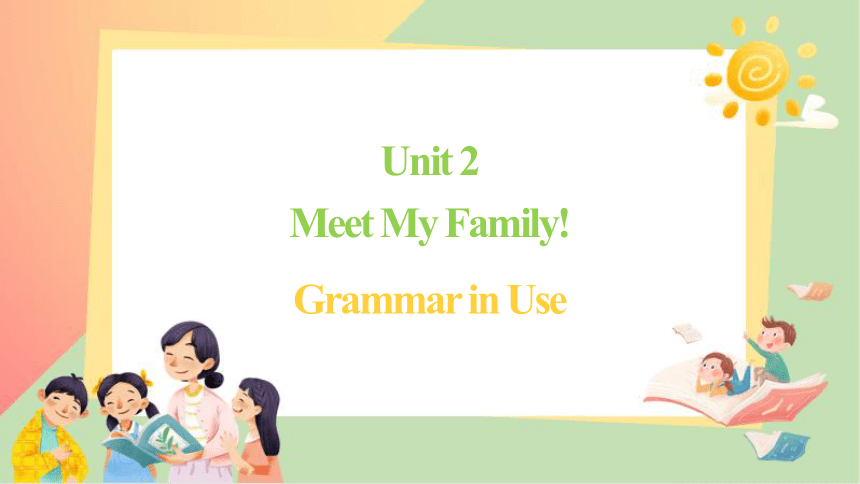 | |
| 格式 | pptx | ||
| 文件大小 | 67.0MB | ||
| 资源类型 | 教案 | ||
| 版本资源 | 仁爱科普版 | ||
| 科目 | 英语 | ||
| 更新时间 | 2024-10-13 20:21:43 | ||
图片预览

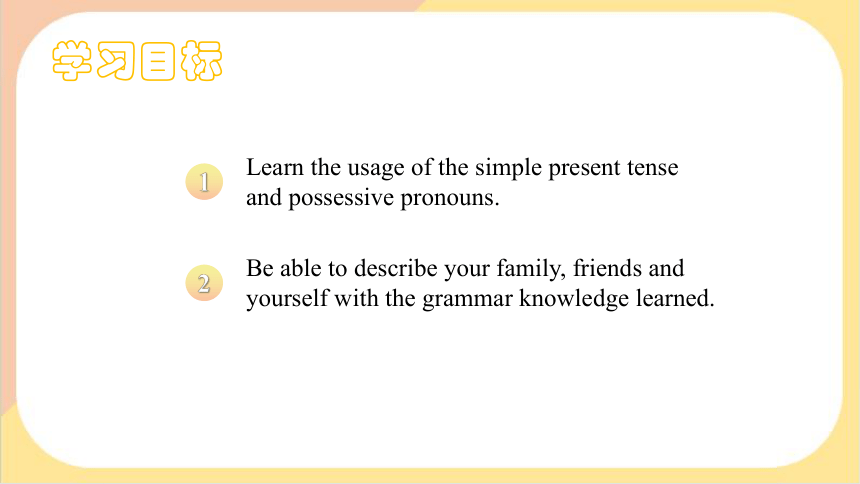
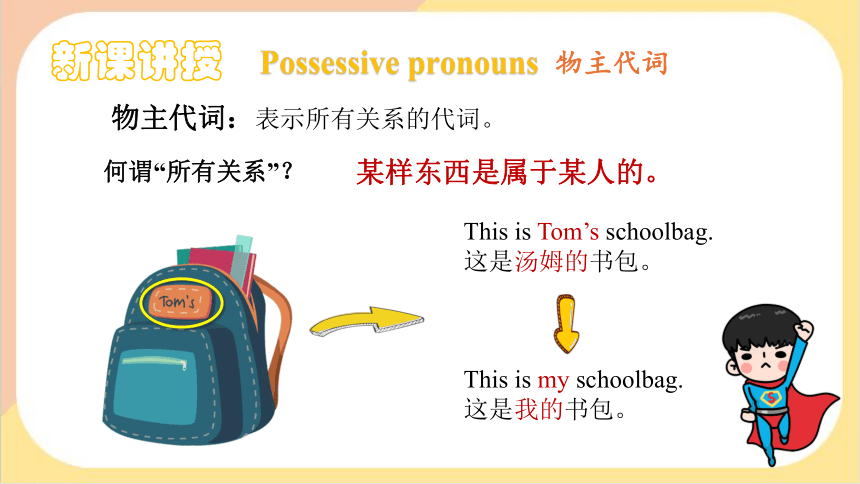
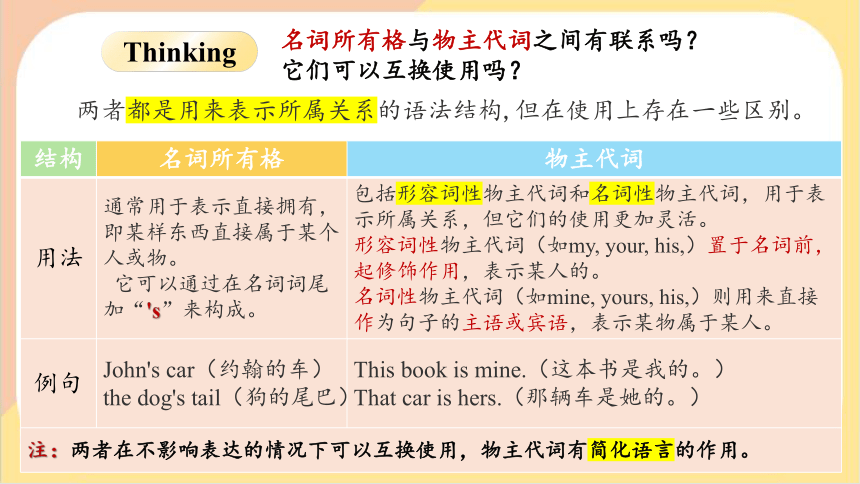
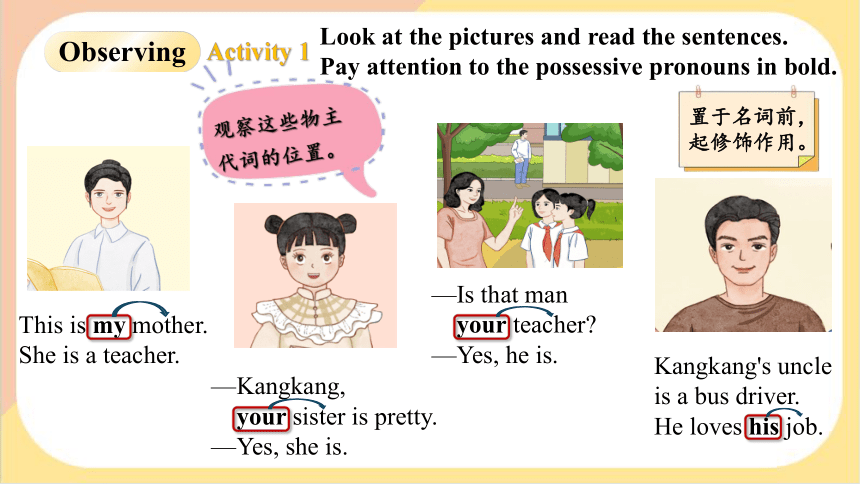
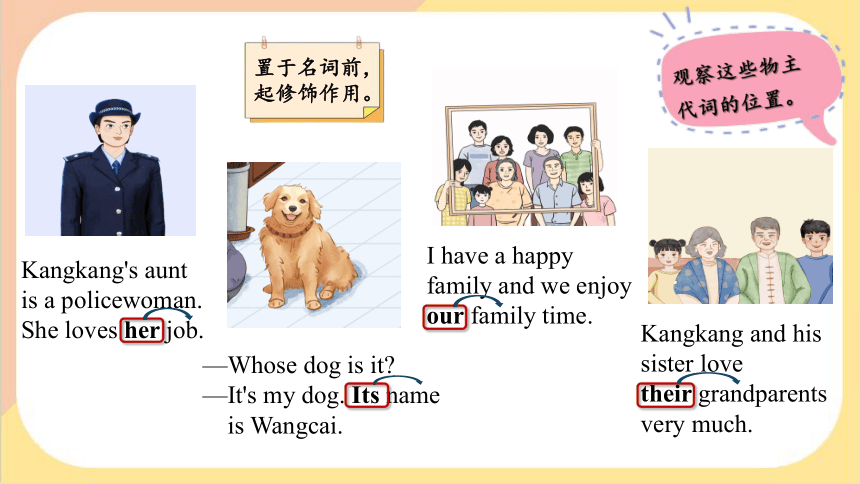
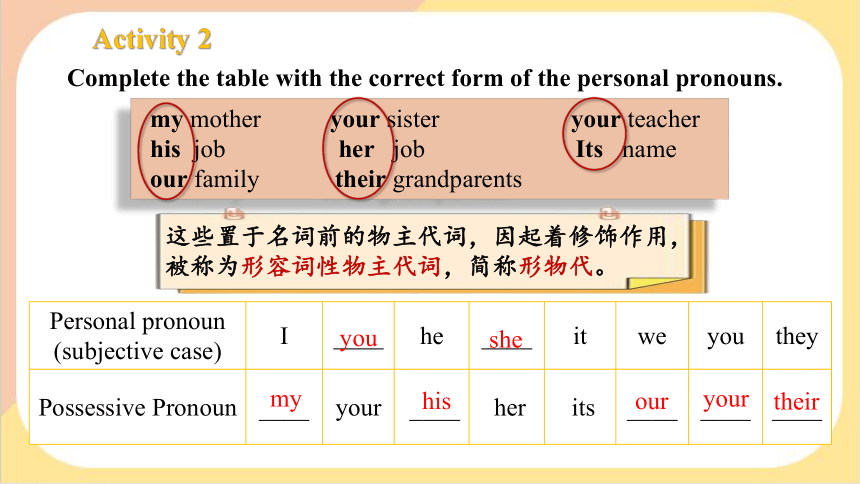
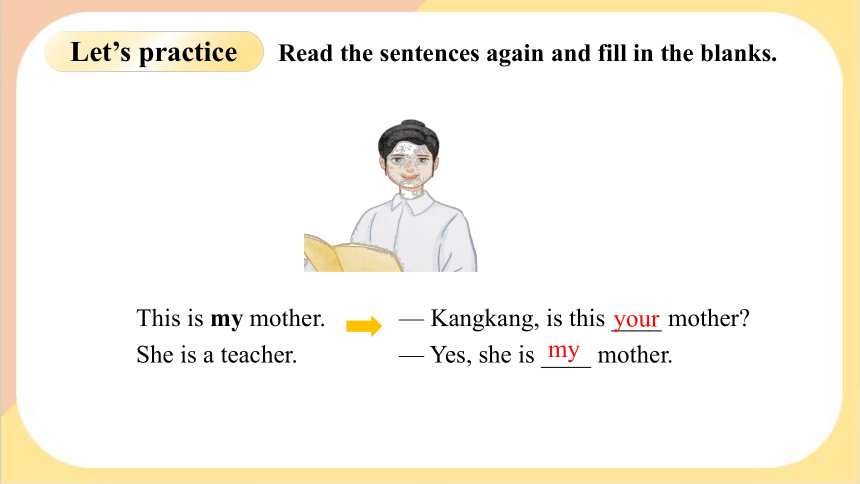
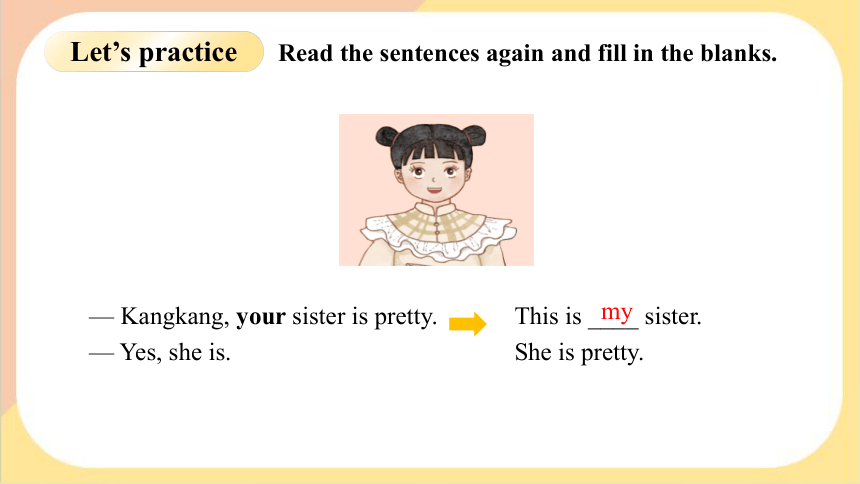
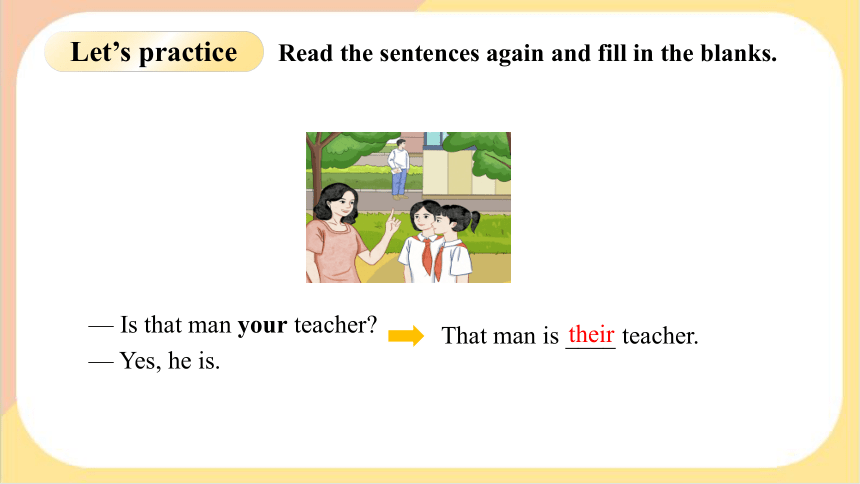
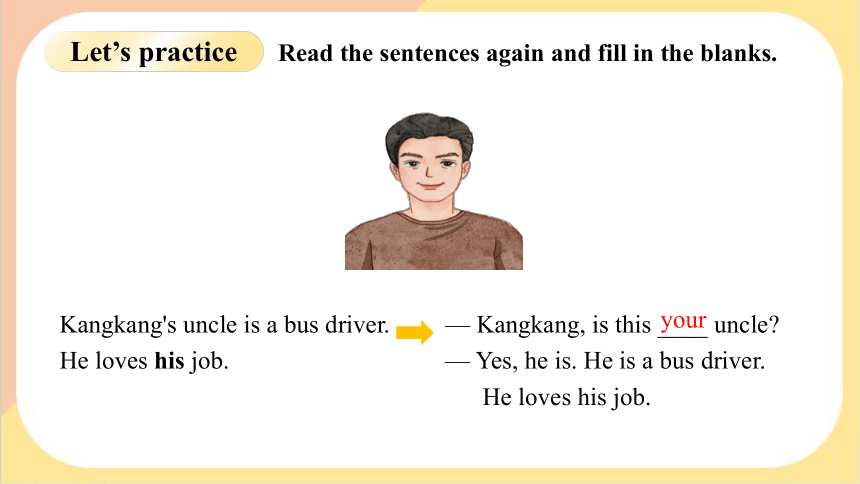
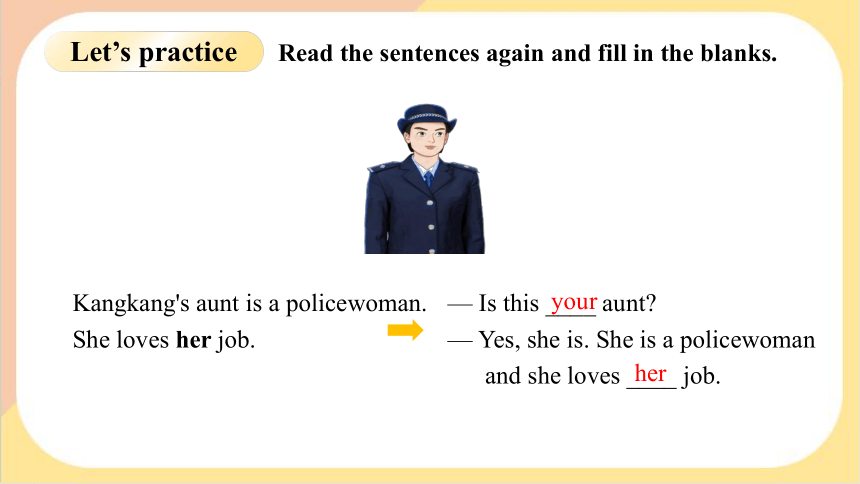
文档简介
(共37张PPT)
Unit 2
Meet My Family!
Grammar in Use
学习目标
1
2
Learn the usage of the simple present tense and possessive pronouns.
Be able to describe your family, friends and yourself with the grammar knowledge learned.
新课讲授
Possessive pronouns 物主代词
物主代词:表示所有关系的代词。
何谓“所有关系”?
某样东西是属于某人的。
This is Tom’s schoolbag.
这是汤姆的书包。
This is my schoolbag.
这是我的书包。
Thinking
两者都是用来表示所属关系的语法结构,但在使用上存在一些区别。
名词所有格与物主代词之间有联系吗?
它们可以互换使用吗?
结构 名词所有格 物主代词
用法 通常用于表示直接拥有,即某样东西直接属于某个人或物。 它可以通过在名词词尾加“'s”来构成。 包括形容词性物主代词和名词性物主代词,用于表示所属关系,但它们的使用更加灵活。
形容词性物主代词(如my, your, his,)置于名词前,起修饰作用,表示某人的。
名词性物主代词(如mine, yours, his,)则用来直接作为句子的主语或宾语,表示某物属于某人。
例句 John's car(约翰的车) the dog's tail(狗的尾巴) This book is mine.(这本书是我的。)
That car is hers.(那辆车是她的。)
注:两者在不影响表达的情况下可以互换使用,物主代词有简化语言的作用。 Observing
Look at the pictures and read the sentences.
Pay attention to the possessive pronouns in bold.
Activity 1
This is my mother.
She is a teacher.
—Kangkang,
your sister is pretty.
—Yes, she is.
—Is that man
your teacher
—Yes, he is.
Kangkang's uncle is a bus driver. He loves his job.
观察这些物主
代词的位置。
置于名词前,起修饰作用。
—Whose dog is it
—It's my dog. Its name
is Wangcai.
I have a happy family and we enjoy our family time.
Kangkang and his sister love
their grandparents very much.
Kangkang's aunt
is a policewoman. She loves her job.
观察这些物主
代词的位置。
置于名词前,起修饰作用。
Complete the table with the correct form of the personal pronouns.
Activity 2
my mother your sister your teacher
his job her job Its name
our family their grandparents
Personal pronoun (subjective case) I ____ he ____ it we you they
Possessive Pronoun ____ your ____ her its ____ ____ ____
这些置于名词前的物主代词,因起着修饰作用,
被称为形容词性物主代词,简称形物代。
my
you
his
she
our
your
their
Let’s practice
Read the sentences again and fill in the blanks.
This is my mother.
She is a teacher.
— Kangkang, is this ____ mother
— Yes, she is ____ mother.
your
my
Let’s practice
Read the sentences again and fill in the blanks.
— Kangkang, your sister is pretty.
— Yes, she is.
This is ____ sister.
She is pretty.
my
Let’s practice
Read the sentences again and fill in the blanks.
That man is ____ teacher.
— Is that man your teacher
— Yes, he is.
their
Let’s practice
Read the sentences again and fill in the blanks.
— Kangkang, is this ____ uncle
— Yes, he is. He is a bus driver.
He loves his job.
Kangkang's uncle is a bus driver.
He loves his job.
your
Let’s practice
Read the sentences again and fill in the blanks.
Kangkang's aunt is a policewoman. She loves her job.
— Is this ____ aunt
— Yes, she is. She is a policewoman
and she loves ____ job.
your
her
Let’s practice
Read the sentences again and fill in the blanks.
—Whose dog is it
—It's my dog. Its name is
Wangcai.
This is ____ dog.
Its name is Wangcai.
my
Let’s practice
Read the sentences again and fill in the blanks.
I have a happy family and we enjoy our family time.
— Is this ____ family
— Yes, it is. I have a happy family
and we enjoy ____ family time.
your
our
Let’s practice
Read the sentences again and fill in the blanks.
Kangkang and his sister love their grandparents very much.
—Kangkang, are they ____ grandparents
—Yes, they are. My sister and I love ____
grandparents very much.
your
our
Read the text and fill in the blanks with correct pronouns.
Activity 3
Mr. and Mrs. Yang have a happy family. They have two children and a cat. This is _______son. ______name is Yang Guang. He likes swimming and riding ______bike. Yang Guang has a sister. __________name is Yang Yu. She is pretty and she likes dancing. The cat is black. __________name is Xiaohei.
their
His
his
Her
Its
[ra d] v. 骑;驾驶
[s n] n. 儿子
Applying
Introduce your family.
I have a happy family. My father is a ... His name is …
He likes ...
The simple present tense (II)
一般现在时态(行为动词)
今天我们将学习:实义动词的
一般现在时
The simple present tense (II)
(主谓宾结构)
一般现在时(Present Simple)
1.表示现在的状态:
e.g. My name is Jack. I am twelve.
我叫杰克。我12岁了。
2.表示经常的或习惯性的动作:
e.g. He gets up at six. 他六点钟起床。
3.表示主语具备的特征或能力等:
e.g. She likes English a lot. 她很喜欢英语。
4.表示客观存在或普遍真理等:
e.g. Cats eat fish. 猫吃鱼。
The earth goes around the sun.
地球围绕太阳转。
Read the conversation. Pay attention to the words in bold.
Activity 1 Pair work
Michael, do you like singing
Yes, I do. My brother likes singing, too.
Does he like playing the guitar
Yes, he does. He plays it very well.
第二人称
第三人称单数
第三人称单数
第三人称单数
Chain game
Make up conversations about your family.
…, do you like …
Yes, I do./No, I don’t.
My … likes ...
Does … like …
Yes, … does./No, … doesn’t. He/She …
一般现在时的构成
主系表 (be动词的一般现在时) 主谓宾
(实义/行为动词的一般现在时)
句子结构 主语 + 系动词 + 表语 ·主语 :句子中的主要行动者或描述 对象,如I, he, the book等。 ·系动词 :连接主语和表语的动词, 表示主语的状态或特征,如am, is, are, look, seem等。 ·表语 :描述主语状态、身份或特征的 成分,可以是名词、形容词、副词、介词短语等,如happy, a teacher, here等。 主语 + 谓语(实义动词)+ 宾语
·主语 :句子中的主要行动者或描述
对象。
·谓语(实义动词) :表示主语的动作
或状态的动词,如eat, write, love等。
·宾语 :动作的对象或承受者,回答
“谁”或“什么”的问题,
如 apples, him, the book等。
例句 My name is Amy. He is ten years old. I often play football after school.
He watches TV every day.
这两种结构构成了英语中一般现在时句子的基本框架。 动词的种类
种类 实义动词 系动词 助动词 情态动词
概念及 用法 表动作,分为及物动词vt.和不及物动词vi. 表状态,系动词本身具有词义,但不能单独用作谓语,必须与表语一起构成系表结构。分为状态系动词(如be)、感官系动词(如look 看起来)等。 也叫辅助动词,无意义,不可单独做谓语。协助主要动词构成时态或者语态,也可构成疑问句和否定句,构成否定句时与否定副词not连用。 如:do/does, will, be+doing(正在进行时中的be)等 表示语气的单词,本身具有一定的词义,但不能独立作谓语,只能和动词原形一起构成谓语。表示说话人对某一动作或状态的看法或主观设想。如:can, should, must等
例句 句子结构 I run. I love my family. 主谓宾 I am happy. You feel sad. That sounds great. 主系表 I don’t know. I am teaching you math. I will help you. 主谓宾 I can speak English.
He must be Mr. Hu.
主谓宾
动词基本形式及变形 (实义动词的一般现在时)
规则 读音 示例
一般动词在词尾加 s 在清辅音后读/s/ 在浊辅音或元音后读/z/ like→likes /la ks/
tell→tells /telz/
play→plays /pla z/
以s, x, ch, sh结尾的动词加 es 读/ z/ guess→guesses /'ɡes z/
teach→teaches /'ti:t z/
以o结尾的动词一般加-es 读/z/ do→does /d z/
go→goes /ɡ z/
以辅音字母加y结尾的动词,先变y改为i,再加 es 读/z/ fly→flies /fla z/
study→studies /'st diz/
当主语是第三人称单数时,动词形式有下列几种变化:
实义动词的使用规则
一般现在时
实义动词
实义动词的一般现在时的构成:(看例句并总结规律,注意观察蓝色和红色字体)
1、I play football every day.
2、You play football every day.
3、My friends play football every day.
4、He plays football every day.
5、Tom plays football every day.
6、My brother plays football every day.
总结规律:
当主语是第三人称单数时,实义动词使用其第三人称单数形式(简称三单形式)。其余情况均用动词原形。
Game time
1. Jack and his sister Amy ________ their mom cook.
A. helps
B. help
2. We ________ swimming.
A. like
B. likes
第三人称复数
第一人称复数
3. Lingling ________ a happy family.
A. have
B. has
4. Bob’s father often ________ basketball with him on weekends.
A. plays
B. play
三单
三单
5. My family ________ many things together.
A. do
B. does
6. Sam and Jack ________ films at Sam’s home.
A. watches
B. watch
此处表示家庭成员,为复数概念。
第三人称复数
Look and fill
实义动词的一般现在时句式
一般现在时
实义动词
肯定句: 主语(如 I/We/You/They)+实义动词(原形)+其他
主语(如 He/She/It)+实义动词的三单形式+其他
1. I _______ (go) swimming on Sundays.
2. My cousin _________ (enjoy) computer games.
3. My parents __________ (watch) TV in the evening.
4. Tom and Simon _______ (like) fish.
5. He _________ (swim) every day.
6. Tom ________ (play) football on weekends.
go
watch
like
swims
plays
enjoys
Look and fill
实义动词的一般现在时句式
一般现在时
实义动词
否定句: 主语(如 I/We/You/They)+ do + not + 动词原形+其他
主语(如 He/She/It)+ does + not + 动词原形+其他
1. I _____________ (not go) swimming on Sundays.
2. My cousin _____________ (not enjoy) computer games.
3. My parents _____________ (not watch) TV in the evening.
4. Tom and Simon _____________ (not like) fish.
5. He _____________ (not swim) every day.
6. Tom _____________ (not play) football on weekends.
don’t go
don’t watch
don’t like
doesn’t swim
doesn’t play
doesn’t enjoy
Complete the tables and learn how to use the simple present tense.
Activity 2
likes
doesn't like
Look and fill
实义动词的一般现在时句式
一般现在时
实义动词
一般疑问句: Do +主语(如 I/we/you/they)+动词原形+其他?
Does +主语(如 he/she/it)+动词原形+其他?
1. ______ you _______ (go) swimming on Sundays
2. ______ your cousin _______ (enjoy) computer games
3. ______ your parents _______ (watch) TV in the evening
4. ______ Tom and Simon ________ (like) fish
5. ______ he ________ (swim) every day
6. ______ Tom _______ (play) football on weekends
Do go
Do watch
Do like
Does swim
Does play
Does enjoy
Complete the tables and learn how to use the simple present tense.
Activity 2
Does
do
doesn't
Read the example and complete the table, and then make short conversations.
Activity 3 Group work
swimming √ × √
playing football × √ ×
running √ × √
Example:
—Does Li Xiang like swimming —Yes, he does.
—Do you like swimming —Yes, I do. /No, I don't.
—What do you like —I like dancing.
Activity
Li Xiang
Xiao Ya
Lingling and Li Mei
Yourself
I. 写出下列动词的第三人称单数形式。
drink ________ go ________ stay ________
make ________ look ________ have ________
pass ________ carry ________ come ________
watch ________ plant ________ fly ________
study_________ brush ________ do ________
teach _________ enjoy ________ like ________
drinks
makes
passes
watches
studies
teaches
goes
looks
carries
plants
brushes
enjoys
stays
has
comes
flies
does
likes
当堂检测
II. 短文填空。
Look! It’s a photo 1 Li Ming’s family. The boy is Li Ming. The girl is
2 sister. They are students. The man and the 3 _ are Li Ming’s father and mother. His father is a teacher and his mother is a bus driver. The old man and the old woman 4 Li Ming’s grandparents. Li Ming has a big
5 _ . Can you count(数数)how many people are there in the photo
1.________ 2.________ 3.________ 4.________ 5.________
of
his
woman
are
family
We learn:
how to use possessive pronouns and the simple present tense.
We can:
ask and answer about one’s likes and dislikes.
课堂总结
Unit 2
Meet My Family!
Grammar in Use
学习目标
1
2
Learn the usage of the simple present tense and possessive pronouns.
Be able to describe your family, friends and yourself with the grammar knowledge learned.
新课讲授
Possessive pronouns 物主代词
物主代词:表示所有关系的代词。
何谓“所有关系”?
某样东西是属于某人的。
This is Tom’s schoolbag.
这是汤姆的书包。
This is my schoolbag.
这是我的书包。
Thinking
两者都是用来表示所属关系的语法结构,但在使用上存在一些区别。
名词所有格与物主代词之间有联系吗?
它们可以互换使用吗?
结构 名词所有格 物主代词
用法 通常用于表示直接拥有,即某样东西直接属于某个人或物。 它可以通过在名词词尾加“'s”来构成。 包括形容词性物主代词和名词性物主代词,用于表示所属关系,但它们的使用更加灵活。
形容词性物主代词(如my, your, his,)置于名词前,起修饰作用,表示某人的。
名词性物主代词(如mine, yours, his,)则用来直接作为句子的主语或宾语,表示某物属于某人。
例句 John's car(约翰的车) the dog's tail(狗的尾巴) This book is mine.(这本书是我的。)
That car is hers.(那辆车是她的。)
注:两者在不影响表达的情况下可以互换使用,物主代词有简化语言的作用。 Observing
Look at the pictures and read the sentences.
Pay attention to the possessive pronouns in bold.
Activity 1
This is my mother.
She is a teacher.
—Kangkang,
your sister is pretty.
—Yes, she is.
—Is that man
your teacher
—Yes, he is.
Kangkang's uncle is a bus driver. He loves his job.
观察这些物主
代词的位置。
置于名词前,起修饰作用。
—Whose dog is it
—It's my dog. Its name
is Wangcai.
I have a happy family and we enjoy our family time.
Kangkang and his sister love
their grandparents very much.
Kangkang's aunt
is a policewoman. She loves her job.
观察这些物主
代词的位置。
置于名词前,起修饰作用。
Complete the table with the correct form of the personal pronouns.
Activity 2
my mother your sister your teacher
his job her job Its name
our family their grandparents
Personal pronoun (subjective case) I ____ he ____ it we you they
Possessive Pronoun ____ your ____ her its ____ ____ ____
这些置于名词前的物主代词,因起着修饰作用,
被称为形容词性物主代词,简称形物代。
my
you
his
she
our
your
their
Let’s practice
Read the sentences again and fill in the blanks.
This is my mother.
She is a teacher.
— Kangkang, is this ____ mother
— Yes, she is ____ mother.
your
my
Let’s practice
Read the sentences again and fill in the blanks.
— Kangkang, your sister is pretty.
— Yes, she is.
This is ____ sister.
She is pretty.
my
Let’s practice
Read the sentences again and fill in the blanks.
That man is ____ teacher.
— Is that man your teacher
— Yes, he is.
their
Let’s practice
Read the sentences again and fill in the blanks.
— Kangkang, is this ____ uncle
— Yes, he is. He is a bus driver.
He loves his job.
Kangkang's uncle is a bus driver.
He loves his job.
your
Let’s practice
Read the sentences again and fill in the blanks.
Kangkang's aunt is a policewoman. She loves her job.
— Is this ____ aunt
— Yes, she is. She is a policewoman
and she loves ____ job.
your
her
Let’s practice
Read the sentences again and fill in the blanks.
—Whose dog is it
—It's my dog. Its name is
Wangcai.
This is ____ dog.
Its name is Wangcai.
my
Let’s practice
Read the sentences again and fill in the blanks.
I have a happy family and we enjoy our family time.
— Is this ____ family
— Yes, it is. I have a happy family
and we enjoy ____ family time.
your
our
Let’s practice
Read the sentences again and fill in the blanks.
Kangkang and his sister love their grandparents very much.
—Kangkang, are they ____ grandparents
—Yes, they are. My sister and I love ____
grandparents very much.
your
our
Read the text and fill in the blanks with correct pronouns.
Activity 3
Mr. and Mrs. Yang have a happy family. They have two children and a cat. This is _______son. ______name is Yang Guang. He likes swimming and riding ______bike. Yang Guang has a sister. __________name is Yang Yu. She is pretty and she likes dancing. The cat is black. __________name is Xiaohei.
their
His
his
Her
Its
[ra d] v. 骑;驾驶
[s n] n. 儿子
Applying
Introduce your family.
I have a happy family. My father is a ... His name is …
He likes ...
The simple present tense (II)
一般现在时态(行为动词)
今天我们将学习:实义动词的
一般现在时
The simple present tense (II)
(主谓宾结构)
一般现在时(Present Simple)
1.表示现在的状态:
e.g. My name is Jack. I am twelve.
我叫杰克。我12岁了。
2.表示经常的或习惯性的动作:
e.g. He gets up at six. 他六点钟起床。
3.表示主语具备的特征或能力等:
e.g. She likes English a lot. 她很喜欢英语。
4.表示客观存在或普遍真理等:
e.g. Cats eat fish. 猫吃鱼。
The earth goes around the sun.
地球围绕太阳转。
Read the conversation. Pay attention to the words in bold.
Activity 1 Pair work
Michael, do you like singing
Yes, I do. My brother likes singing, too.
Does he like playing the guitar
Yes, he does. He plays it very well.
第二人称
第三人称单数
第三人称单数
第三人称单数
Chain game
Make up conversations about your family.
…, do you like …
Yes, I do./No, I don’t.
My … likes ...
Does … like …
Yes, … does./No, … doesn’t. He/She …
一般现在时的构成
主系表 (be动词的一般现在时) 主谓宾
(实义/行为动词的一般现在时)
句子结构 主语 + 系动词 + 表语 ·主语 :句子中的主要行动者或描述 对象,如I, he, the book等。 ·系动词 :连接主语和表语的动词, 表示主语的状态或特征,如am, is, are, look, seem等。 ·表语 :描述主语状态、身份或特征的 成分,可以是名词、形容词、副词、介词短语等,如happy, a teacher, here等。 主语 + 谓语(实义动词)+ 宾语
·主语 :句子中的主要行动者或描述
对象。
·谓语(实义动词) :表示主语的动作
或状态的动词,如eat, write, love等。
·宾语 :动作的对象或承受者,回答
“谁”或“什么”的问题,
如 apples, him, the book等。
例句 My name is Amy. He is ten years old. I often play football after school.
He watches TV every day.
这两种结构构成了英语中一般现在时句子的基本框架。 动词的种类
种类 实义动词 系动词 助动词 情态动词
概念及 用法 表动作,分为及物动词vt.和不及物动词vi. 表状态,系动词本身具有词义,但不能单独用作谓语,必须与表语一起构成系表结构。分为状态系动词(如be)、感官系动词(如look 看起来)等。 也叫辅助动词,无意义,不可单独做谓语。协助主要动词构成时态或者语态,也可构成疑问句和否定句,构成否定句时与否定副词not连用。 如:do/does, will, be+doing(正在进行时中的be)等 表示语气的单词,本身具有一定的词义,但不能独立作谓语,只能和动词原形一起构成谓语。表示说话人对某一动作或状态的看法或主观设想。如:can, should, must等
例句 句子结构 I run. I love my family. 主谓宾 I am happy. You feel sad. That sounds great. 主系表 I don’t know. I am teaching you math. I will help you. 主谓宾 I can speak English.
He must be Mr. Hu.
主谓宾
动词基本形式及变形 (实义动词的一般现在时)
规则 读音 示例
一般动词在词尾加 s 在清辅音后读/s/ 在浊辅音或元音后读/z/ like→likes /la ks/
tell→tells /telz/
play→plays /pla z/
以s, x, ch, sh结尾的动词加 es 读/ z/ guess→guesses /'ɡes z/
teach→teaches /'ti:t z/
以o结尾的动词一般加-es 读/z/ do→does /d z/
go→goes /ɡ z/
以辅音字母加y结尾的动词,先变y改为i,再加 es 读/z/ fly→flies /fla z/
study→studies /'st diz/
当主语是第三人称单数时,动词形式有下列几种变化:
实义动词的使用规则
一般现在时
实义动词
实义动词的一般现在时的构成:(看例句并总结规律,注意观察蓝色和红色字体)
1、I play football every day.
2、You play football every day.
3、My friends play football every day.
4、He plays football every day.
5、Tom plays football every day.
6、My brother plays football every day.
总结规律:
当主语是第三人称单数时,实义动词使用其第三人称单数形式(简称三单形式)。其余情况均用动词原形。
Game time
1. Jack and his sister Amy ________ their mom cook.
A. helps
B. help
2. We ________ swimming.
A. like
B. likes
第三人称复数
第一人称复数
3. Lingling ________ a happy family.
A. have
B. has
4. Bob’s father often ________ basketball with him on weekends.
A. plays
B. play
三单
三单
5. My family ________ many things together.
A. do
B. does
6. Sam and Jack ________ films at Sam’s home.
A. watches
B. watch
此处表示家庭成员,为复数概念。
第三人称复数
Look and fill
实义动词的一般现在时句式
一般现在时
实义动词
肯定句: 主语(如 I/We/You/They)+实义动词(原形)+其他
主语(如 He/She/It)+实义动词的三单形式+其他
1. I _______ (go) swimming on Sundays.
2. My cousin _________ (enjoy) computer games.
3. My parents __________ (watch) TV in the evening.
4. Tom and Simon _______ (like) fish.
5. He _________ (swim) every day.
6. Tom ________ (play) football on weekends.
go
watch
like
swims
plays
enjoys
Look and fill
实义动词的一般现在时句式
一般现在时
实义动词
否定句: 主语(如 I/We/You/They)+ do + not + 动词原形+其他
主语(如 He/She/It)+ does + not + 动词原形+其他
1. I _____________ (not go) swimming on Sundays.
2. My cousin _____________ (not enjoy) computer games.
3. My parents _____________ (not watch) TV in the evening.
4. Tom and Simon _____________ (not like) fish.
5. He _____________ (not swim) every day.
6. Tom _____________ (not play) football on weekends.
don’t go
don’t watch
don’t like
doesn’t swim
doesn’t play
doesn’t enjoy
Complete the tables and learn how to use the simple present tense.
Activity 2
likes
doesn't like
Look and fill
实义动词的一般现在时句式
一般现在时
实义动词
一般疑问句: Do +主语(如 I/we/you/they)+动词原形+其他?
Does +主语(如 he/she/it)+动词原形+其他?
1. ______ you _______ (go) swimming on Sundays
2. ______ your cousin _______ (enjoy) computer games
3. ______ your parents _______ (watch) TV in the evening
4. ______ Tom and Simon ________ (like) fish
5. ______ he ________ (swim) every day
6. ______ Tom _______ (play) football on weekends
Do go
Do watch
Do like
Does swim
Does play
Does enjoy
Complete the tables and learn how to use the simple present tense.
Activity 2
Does
do
doesn't
Read the example and complete the table, and then make short conversations.
Activity 3 Group work
swimming √ × √
playing football × √ ×
running √ × √
Example:
—Does Li Xiang like swimming —Yes, he does.
—Do you like swimming —Yes, I do. /No, I don't.
—What do you like —I like dancing.
Activity
Li Xiang
Xiao Ya
Lingling and Li Mei
Yourself
I. 写出下列动词的第三人称单数形式。
drink ________ go ________ stay ________
make ________ look ________ have ________
pass ________ carry ________ come ________
watch ________ plant ________ fly ________
study_________ brush ________ do ________
teach _________ enjoy ________ like ________
drinks
makes
passes
watches
studies
teaches
goes
looks
carries
plants
brushes
enjoys
stays
has
comes
flies
does
likes
当堂检测
II. 短文填空。
Look! It’s a photo 1 Li Ming’s family. The boy is Li Ming. The girl is
2 sister. They are students. The man and the 3 _ are Li Ming’s father and mother. His father is a teacher and his mother is a bus driver. The old man and the old woman 4 Li Ming’s grandparents. Li Ming has a big
5 _ . Can you count(数数)how many people are there in the photo
1.________ 2.________ 3.________ 4.________ 5.________
of
his
woman
are
family
We learn:
how to use possessive pronouns and the simple present tense.
We can:
ask and answer about one’s likes and dislikes.
课堂总结
同课章节目录
